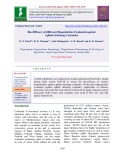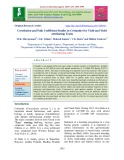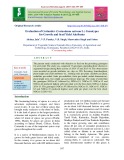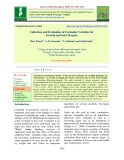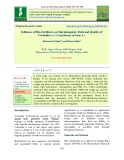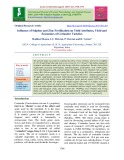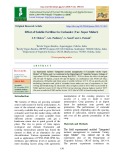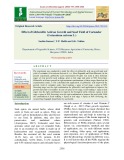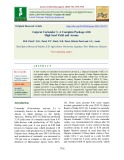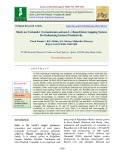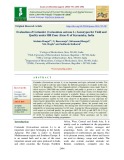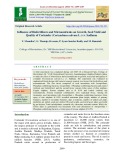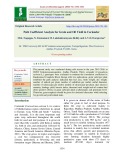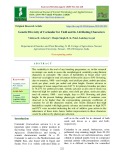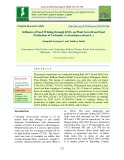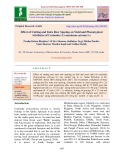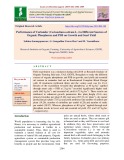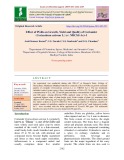
Seed yield of coriander
-
The obtained results showed that the microclimate affected planting date in the studied region which indicated that planting in the first third of December improved plant traits as significantly produced the heaviest weight of 1000 seeds, fruit yield/plant and /fed (1923.77 kg/fed).
 17p
17p  schindler
schindler
 30-12-2021
30-12-2021
 15
15
 0
0
 Download
Download
-
A field experiment was conducted at Anand Agricultural University, Anand during Rabi season 2019-20 to assess the bio-efficacy of various biopesticides against aphids infesting coriander. Of the nine biopesticides evaluated against aphids infesting coriander, application of tobacco decoction was found the most effective followed by ginger rhizome extract and garlic bulb extract with coriander seed yield of 449, 437, and 420 kg/ha, respectively.
 10p
10p  cothumenhmong11
cothumenhmong11
 11-05-2021
11-05-2021
 12
12
 2
2
 Download
Download
-
Coriander is an annual herbaceous spice plant, a family member of Umbelliferae. In India it is grown in 4,47,000 ha area with annual production of 3,14,000 MT during 2013-14 (Anonymous, 2015). This data is shortening as compared to previous statistics with respect to production, this is because of current knowledge about its characteristic association and their effects is incomplete. To fulfill these gaps, an investigation was conducted during the 2014-15 at research farm in Hisar. Data for 11 quality traits were measured and statistically analysed.
 7p
7p  caygaocaolon8
caygaocaolon8
 07-11-2020
07-11-2020
 13
13
 1
1
 Download
Download
-
The present study conducted with objective to find out the promising genotypes for seed yield. The study was comprised 73 genotypes (including three checks) in augmented design during Rabi seasons of 2014-15 and 2015-16.
 9p
9p  nguathienthan8
nguathienthan8
 20-10-2020
20-10-2020
 6
6
 1
1
 Download
Download
-
The present investigation entitled “Collection and evaluation of coriander genotypes for seed purpose” was carried out during rabi season of the year 2018 & 2019 at the College of Agriculture, Bheemarayanagudi. The study consisted of sixteen coriander varieties using randomized block design and each treatment was replicated thrice. The varieties viz., Suguna, Sindhu, Supha, AD-1, Sadana, Swathi, Susthira, GDLC 1, DWDC-1, Sudha, Co 1, Co 2, Gcr-1, Gcr-2, Rcr436, Chamnal Local were studied under investigation.
 6p
6p  kethamoi7
kethamoi7
 26-08-2020
26-08-2020
 12
12
 1
1
 Download
Download
-
A field study was carried out in Horticulture Research Farm, I.G.K.V. Raipur (C.G.) during rabi season 2007-08.The results indicated that vegetative growth contributing characters (leaf area index , fresh and dry weight per plant were influenced by combination of 100%K and 75% NP along with Azotobacter, Azospirillum and PSB (T8). Yield contributing characters (like number of seed per umbellet, 1000-seed weight (g), total no of seed per plant (g) and seed yield (q/ha) maximum in (T8) were given better performance respectively over all the treatments.
 6p
6p  caygaocaolon6
caygaocaolon6
 30-07-2020
30-07-2020
 12
12
 2
2
 Download
Download
-
The present study was aimed to examine the effect of two varieties, four levels of sulphur (0, 20, 40 and 60 kg S/ha) and four levels of zinc (0, 2.5, 5.0 and 7.5 kg Zn/ha) making 32 treatment combination under split plot design with three replications. Results showed that significantly increased umbels/plant, umbellets/umbel, seeds/umbel, seed (1409 kg/ha), stover and biological yields, and net returns (Rs 39396/ha) were obtained with coriander variety RCr-436 as compared to variety RCr-435.
 7p
7p  kethamoi6
kethamoi6
 29-06-2020
29-06-2020
 11
11
 1
1
 Download
Download
-
An experiment entitled “Integrated nutrient management of Coriander variety Super Midori” of Tokita seed was conducted in the Department of Vegetable Science, College of Agriculture, OUAT, Bhubaneswar during Rabi2013 - 2014 to assess the effect of nitrogen (50, 60 and 70 kg/ha), potash (50 and 60 kg/ha) in combination with FYM (20 t/ha), phosphorous (40 kg/ha) and foliar spray of soluble fertilizer (13: 0: 45) on growth, growth attributing characters and yield of coriander leaves under two sets of experiment i.e. line sowing and broadcasting. In interaction effect a highest yield of 20.
 5p
5p  quenchua6
quenchua6
 15-06-2020
15-06-2020
 10
10
 1
1
 Download
Download
-
The experiment was conducted to study the effect of gibberellic acid on growth and seed yield of coriander (Coriandrum Sativum L.) cv. Hisar Sugandh and Hisar Bhoomit. In the present experiment, gibberellic acid concentration 50 ppm was used at three different stages of crop growth (seed soaking, spray at leaf stage and spray at 50% flowering). Gibberellic acid was sprayed in eight treatment combinations of three stages.
 9p
9p  kethamoi5
kethamoi5
 03-06-2020
03-06-2020
 10
10
 0
0
 Download
Download
-
A new variety of coriander (Coriandrum sativum L.), Gujarat Coriander 3 (GCo 3) was tested under 12 trials for 6 years across the country. Under Gujarat climatic conditions, GCo 3 had recorded 1501.32 kg/ha seed yield, which was 17.00 per cent higher seed yield than check variety Gujarat Coriander 2 (GCo 2).
 10p
10p  caygaocaolon5
caygaocaolon5
 27-05-2020
27-05-2020
 8
8
 1
1
 Download
Download
-
A field experiment comprising ten treatments of intercropping systems replicated four times was conducted in Randomized Block Design with during rabi season, 2016-17. Results indicated that sole coriander exhibited the higher plant height and number of branches per plant 60 DAS, 90 DAS and at harvest as compared to different intercropping system. Further, results showed that sole coriander exhibited significantly highest values of yield attributes viz.
 6p
6p  nguaconbaynhay5
nguaconbaynhay5
 11-05-2020
11-05-2020
 8
8
 0
0
 Download
Download
-
Coriander (Coriandrum sativum L.) is an important seed spice cultivated in India. The effort was made to cultivate and evaluate the different genotypes of coriander in hill zone (Zone-9) of Karnataka. The Uttara Kannada district of Karnataka comes under Zone-9, which receives 2500-3000 mm rainfall annually and paddy is grown as a rainfed crop during Kharif season. After the harvest of paddy the land is kept vacant, even though there is sufficient amount of residual moisture is available.
 9p
9p  angicungduoc4
angicungduoc4
 26-04-2020
26-04-2020
 7
7
 2
2
 Download
Download
-
A field experiment was conducted during rabi 2015-16 at Research Farm, College of Horticulture, Dr. Y.S.R. Horticultural University, Anantharajupet (Andhra Pradesh), India, to study the effect of biofertilizers and micronutrients on growth, seed yield and quality of coriander (Coriandrum sativum L.) cv. Sadhana. The experiment was evaluated in randomized block design with factorial concept consists two factors like biofertilizers and micronutrients.
 8p
8p  caygaocaolon4
caygaocaolon4
 01-04-2020
01-04-2020
 12
12
 2
2
 Download
Download
-
The present study was conducted during rabi season in the year 2015-2016 at HCRI Venkataramannagudem, Andhra Pradesh. Thirty coriander (Coriandrum sativum L.) genotypes were evaluated to estimate the correlation coefficient in Randomized Complete Block Design with two replications.
 8p
8p  trinhthamhodang4
trinhthamhodang4
 22-03-2020
22-03-2020
 8
8
 1
1
 Download
Download
-
The variability is the soul of any breeding programme, so, in this research an attempt was made to assess the morphological variability using thirteen characters in coriander. The values of heritability in broad sense were observed very high for total oil content followed by days to 50% flowering, days to maturity, 1000 - seed weight, seed yield per plant, umbels per plant, seeds per plant, seeds per umbel and plant height. Genetic advance as percentage of mean ranged between 0.67 % for primary branches per plant, to 78.27% for umbels per plant.
 7p
7p  chauchaungayxua4
chauchaungayxua4
 18-03-2020
18-03-2020
 13
13
 1
1
 Download
Download
-
The present experiment was conducted during Rabi 2017-18 and 2018-19 at Research Farm, Bidhan Chandra Krishi Viswavidyalaya, Mohanpur, Nadia, West Bengal. The design of experiment was split plot with two factor analysis comprising four concentrations of KNO3 [viz. T1-0.5% of KNO3, T2-0.25% of KNO3, T3-0.1% of KNO3, T0-hydrated seed (control)] as first factor and three durations of soaking [viz. D1-12 hours of soaking, D2-16 hours of soaking, D3-20 hours of soaking] as second factor.
 7p
7p  chauchaungayxua4
chauchaungayxua4
 18-03-2020
18-03-2020
 9
9
 2
2
 Download
Download
-
Effect of cutting and intra row spacing on leaf and seed yield of coriander (Coriandrum sativum L) was carried out in cv. Solan Selection at Dr. YSPUHF, Solan (HP) during Rabi 2015. The treatments comprised of three cutting and five intra row spacing. Coriander sown at closer spacing 30 × 2.5 cm and left for seed production after two cuttings (60 & 75 DAS) gave the highest leaf yield i.e. 55.53 q ha-1 along with seed yield of 17.44 q ha-1 with the maximum B : C ratio (3.39 : 1), whereas, sowing at spacing 30 × 7.
 6p
6p  caygaocaolon3
caygaocaolon3
 27-02-2020
27-02-2020
 13
13
 1
1
 Download
Download
-
Field experiment was conducted during rabi-2018 at Research Institute of Organic Farming field unit, UAS, GKVK, Bengaluru to study the different sources of organic phosphorus and PSB on growth, seed yield and essential oil content in coriander laid out in Randomized Complete Block Design with 10 treatments replicated thrice and the variety used was Co Cr-4. Results of the experiment revealed that phosphorus at 40 kg ha-1 applied through neem cake + PSB at 2 kg ha-1 recorded significantly higher seed yield (665 kg ha-1 ) and essential oil yield (4.72 kg ha-1 ).
 6p
6p  caygaocaolon3
caygaocaolon3
 27-02-2020
27-02-2020
 16
16
 1
1
 Download
Download
-
The present investigation entitled “Collection and evaluation of coriander genotypes for seed purpose” was carried out during rabi season of the year 2018 at the College of Agriculture, Bheemarayanagudi. The study consisted of sixteen coriander varieties using randomized block design and each treatment was replicated thrice. The varieties viz., Suguna, Sindhu, Supha, AD-1, Sadana, Swathi, Susthira, GDLC 1, DWDC-1, Sudha, Co 1, Co 2, Gcr-1, Gcr-2, Rcr436, Chamnal Local were studied under investigation. The results revealed that variety DWDC-1 was found superior in seed yield (13.
 6p
6p  chauchaungayxua3
chauchaungayxua3
 07-02-2020
07-02-2020
 11
11
 0
0
 Download
Download
-
An experiment was conducted during rabi 2016-17 at Research Farm, College of Horticulture, Mandsaur (Madhya Pradesh) to study the effect of PGRs on growth yield and quality of coriander (Coriandrum sativum L.) cv. NRCSS Acr-1. The ten treatments included control (water spray), three concentrations of NAA (25, 50 and 75 ppm), three concentrations of GA3 (10, 25 and 50 ppm) and three concentrations of Cycocel (100, 200 and 300 ppm).
 6p
6p  nguathienthan2
nguathienthan2
 26-12-2019
26-12-2019
 15
15
 0
0
 Download
Download
CHỦ ĐỀ BẠN MUỐN TÌM










